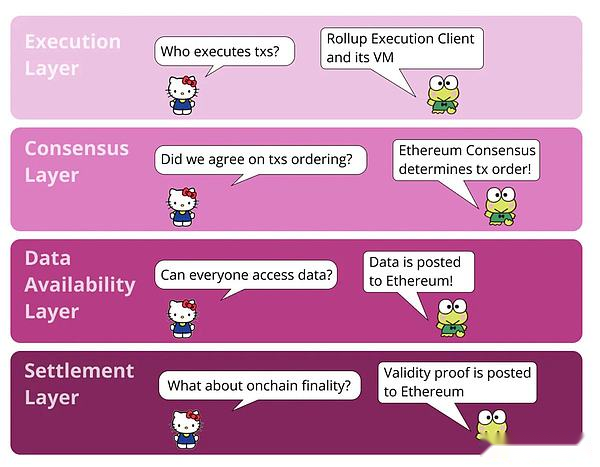
Author: Jun, Bankless; compiled by Deng Tong, Bitchain Vision
The expansion of Ethereum has been one of the most discussed challenges in the cryptocurrency space.To solve this problem, the community chose a rollup-centric approach.The idea is simple:Rather than hosting all applications on Ethereum, focus on rollups that offer faster and cheaper transactions while still returning to Ethereum.So you can get faster and cheaper transactions, but you can still keep Ethereum safe.
We now have optimistic rollups like Arbitrum, OP Mainnet, and Base, and zk-rollups like ZKsync, which all contribute to the growth of Ethereum.They bring more users and value to Ethereum, however, people are still worried about their dependence on centralized sorters and fragmentation of cross-chain liquidity.
This is where rollup comes in.They integrate more closely with Ethereum’s infrastructure, helping to retain value in the ecosystem.This new method of building rollup can bring additional value to Ethereum and ETH.
What is based on rollup ?
Rollup based on rollup or L1 sorting is a rollup where the underlying L1 chain (such as Ethereum) directly manages transaction sorting.
Unlike traditional rollups that rely on their own sorters, rollups leverage L1’s security, activity, and decentralization by outsourcing transaction sorting to L1’s infrastructure.The infrastructure includes proposers, searchers, builders, and other participants who contain rollup-based blocks without permission in the L1 block.
Initially, this approach seemed inefficient – Vitalik once called it “complete anarchy” in his 2021 article on rollup.But today based on rollup has become more feasible.In 2023, Ethereum researcher Justin Drake brought this concept back to focus, believing that based on rollup is not only more aligned with Ethereum, but also eliminates the need to make separate security assumptions for each new rollup.
What does rollup-based work?
Based on rollup, L1 is used for consensus, data availability and settlement layers, and the execution is processed independently.For example, when Ethereum is the underlying L1, the key layers based on rollup are as follows:
-
Execution layer — managed by the rollup itself, and transactions are executed off-chain.
-
Consensus layer — Rely on the Ethereum validator to sort transactions.
-
Data Availability Layer — Use Ethereum as the DA layer to ensure that anyone can verify transaction data.
-
Settlement layer — also part of Ethereum, recording the final transaction status of rollup.

Rollup based rollup uses Ethereum for everything from transaction sorting to settlement.While this approach doesn’t seem to be much different from traditional rollups, it fundamentally changes how sorting is handled.Rollup based on rollups does not rely entirely on a separate sorter, but uses Ethereum itself for transaction sorting.
In traditional rollups, users send their transactions to a dedicated sorter—essentially a machine operated by the rollup team.The sorter is responsible for collecting user transactions, determining their order, and packaging them into blocks published on Ethereum.
In contrast, rollup-based rollup directs user transactions to block builders who manage Ethereum and rollups.This use of Ethereum infrastructure allows rollups to benefit from the same guarantees provided by Ethereum, thus allowing transactions to achieve finality more reliably than non-rollup-based rollups.
Top projects based on rollup
As a relatively new concept, based on rollup is still under development, with some key projects emerging:
-
Taiko — Ethereum equivalent (type 1) ZK-EVM, maximum compatibility with Ethereum and does not introduce additional trust assumptions.
-
KeySpace — Coinbase’s zk-rollup designed to create smart wallets that can be used on any chain.
-
Taiko Gwyneth — Using pre-confirm rollup designed to synchronously combine with Ethereum.
-
UniFi — A rollup based on a process developed by the PufferFi team that uses pre-confirmation to enhance the user experience.
-
Spire Labs — A framework on Ethereum that allows developers to build application-based chains.
Why use rollup based?
As Justin Drake outlined in his original post, based rollup is worthy of your attention for the following reasons:
-
Inherited activity and decentralization – One of the main advantages of rollup-based is their ability to inherit the activity guarantees of the underlying L1 chain.As long as L1 is available, rollup can also run.
-
Economic consistency with L1 – The rollup-based economic model establishes a mutually beneficial relationship with L1.The priority fees and MEVs of these rollups will naturally flow to L1.This synergy not only adds value to the base layer, but also increases the legitimacy and brand awareness of the rollup itself, thanks to the Ethereum community.
-
Cost Efficiency – Outsourcing orders to Ethereum reduces rollup-based development costs, speeds up time to market and reduces user costs (especially on scale).
However, there are trade-offs based on rollup.They sacrificed some profitability by relying on Ethereum for sorting, missing out on priority fees and MEVs.In addition, they face challenges inherent in Ethereum, such as slow block time, which can lead to latency issues.
These challenges explain why existing rollups are designed with their own sorters—to provide a fast user experience.While solutions such as pre-confirmation of inclusion and execution are being discussed as potential ways to enhance rollup-based user experience, it is still uncertain whether such improvements can be achieved without introducing trusted third parties.What people really argue is that these changes can compromise the basic simplicity and security that initially make rollup-based appealing.








